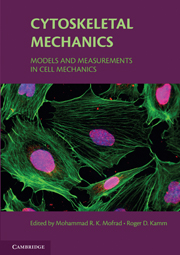Book contents
- Frontmatter
- Contents
- List of Contributors
- Preface
- 1 Introduction, with the biological basis for cell mechanics
- 2 Experimental measurements of intracellular mechanics
- 3 The cytoskeleton as a soft glassy material
- 4 Continuum elastic or viscoelastic models for the cell
- 5 Multiphasic models of cell mechanics
- 6 Models of cytoskeletal mechanics based on tensegrity
- 7 Cells, gels, and mechanics
- 8 Polymer-based models of cytoskeletal networks
- 9 Cell dynamics and the actin cytoskeleton
- 10 Active cellular protrusion: continuum theories and models
- 11 Summary
- Index
5 - Multiphasic models of cell mechanics
Published online by Cambridge University Press: 10 November 2009
- Frontmatter
- Contents
- List of Contributors
- Preface
- 1 Introduction, with the biological basis for cell mechanics
- 2 Experimental measurements of intracellular mechanics
- 3 The cytoskeleton as a soft glassy material
- 4 Continuum elastic or viscoelastic models for the cell
- 5 Multiphasic models of cell mechanics
- 6 Models of cytoskeletal mechanics based on tensegrity
- 7 Cells, gels, and mechanics
- 8 Polymer-based models of cytoskeletal networks
- 9 Cell dynamics and the actin cytoskeleton
- 10 Active cellular protrusion: continuum theories and models
- 11 Summary
- Index
Summary
ABSTRACT: Cells are highly complex structures whose physiology and biomechanical properties depend on the interactions among the varying concentrations of water, charged or uncharged macromolecules, ions, and other molecular components contained within the cytoplasm. To further investigate the mechanistic basis of the mechanical behaviors of cells, recent studies have developed models of single cells and cell–matrix interactions that use multiphasic constitutive laws to represent the interactions among solid, fluid, and in some cases, ionic phases of cells. The goals of such studies have been to characterize the relative contributions of different physical mechanisms responsible for empirically observed phenomena such as cell viscoelasticity or volume change under mechanical or osmotic loading, and to account for the coupling of mechanical, chemical, and electrical events within living cells. This chapter describes several two-phase (fluid-solid) or three-phase (fluid-solid-ion) models, originally developed for studying soft hydrated tissues, that have been extended to describe the biomechanical behavior of individual cells or cell–matrix interactions in various tissue systems. The application of such “biphasic” or “triphasic” continuum-based approaches can be combined with other structurally based models to study the interactions of the different constitutive phases in governing cell mechanical behavior.
Introduction
Cells of the human body are regularly subjected to a complex mechanical environment, consisting of temporally and spatially varying stresses, strains, fluid flow, osmotic pressure, and other biophysical factors. In many cases, the mechanical properties and the rheology of cells play a critical role in their ability to withstand mechanical loading while performing their physiologic functions. In other cases, mechanical factors serve as important signals that influence, and potentially regulate, cell phenotype in both health and disease.
- Type
- Chapter
- Information
- Cytoskeletal MechanicsModels and Measurements in Cell Mechanics, pp. 84 - 102Publisher: Cambridge University PressPrint publication year: 2006
- 7
- Cited by



